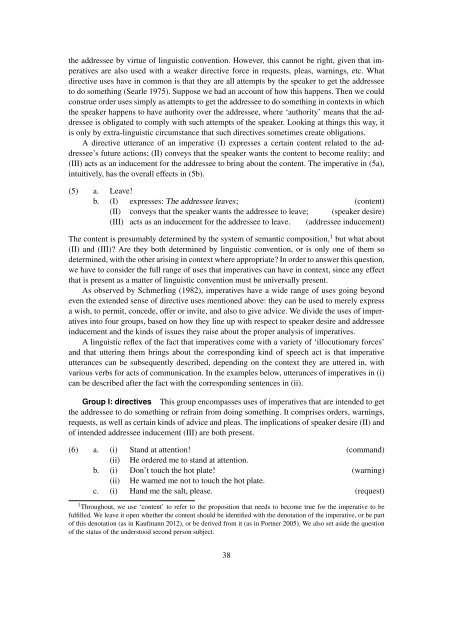Empirical Issues in Syntax and Semantics 9 (EISS 9 ... - CSSP - CNRS
Empirical Issues in Syntax and Semantics 9 (EISS 9 ... - CSSP - CNRS
Empirical Issues in Syntax and Semantics 9 (EISS 9 ... - CSSP - CNRS
Create successful ePaper yourself
Turn your PDF publications into a flip-book with our unique Google optimized e-Paper software.
the addressee by virtue of l<strong>in</strong>guistic convention. However, this cannot be right, given that imperatives<br />
are also used with a weaker directive force <strong>in</strong> requests, pleas, warn<strong>in</strong>gs, etc. What<br />
directive uses have <strong>in</strong> common is that they are all attempts by the speaker to get the addressee<br />
to do someth<strong>in</strong>g (Searle 1975). Suppose we had an account of how this happens. Then we could<br />
construe order uses simply as attempts to get the addressee to do someth<strong>in</strong>g <strong>in</strong> contexts <strong>in</strong> which<br />
the speaker happens to have authority over the addressee, where ‘authority’ means that the addressee<br />
is obligated to comply with such attempts of the speaker. Look<strong>in</strong>g at th<strong>in</strong>gs this way, it<br />
is only by extra-l<strong>in</strong>guistic circumstance that such directives sometimes create obligations.<br />
A directive utterance of an imperative (I) expresses a certa<strong>in</strong> content related to the addressee’s<br />
future actions; (II) conveys that the speaker wants the content to become reality; <strong>and</strong><br />
(III) acts as an <strong>in</strong>ducement for the addressee to br<strong>in</strong>g about the content. The imperative <strong>in</strong> (5a),<br />
<strong>in</strong>tuitively, has the overall effects <strong>in</strong> (5b).<br />
(5) a. Leave!<br />
b. (I) expresses: The addressee leaves; (content)<br />
(II) conveys that the speaker wants the addressee to leave; (speaker desire)<br />
(III) acts as an <strong>in</strong>ducement for the addressee to leave. (addressee <strong>in</strong>ducement)<br />
The content is presumably determ<strong>in</strong>ed by the system of semantic composition, 1 but what about<br />
(II) <strong>and</strong> (III)? Are they both determ<strong>in</strong>ed by l<strong>in</strong>guistic convention, or is only one of them so<br />
determ<strong>in</strong>ed, with the other aris<strong>in</strong>g <strong>in</strong> context where appropriate? In order to answer this question,<br />
we have to consider the full range of uses that imperatives can have <strong>in</strong> context, s<strong>in</strong>ce any effect<br />
that is present as a matter of l<strong>in</strong>guistic convention must be universally present.<br />
As observed by Schmerl<strong>in</strong>g (1982), imperatives have a wide range of uses go<strong>in</strong>g beyond<br />
even the extended sense of directive uses mentioned above: they can be used to merely express<br />
a wish, to permit, concede, offer or <strong>in</strong>vite, <strong>and</strong> also to give advice. We divide the uses of imperatives<br />
<strong>in</strong>to four groups, based on how they l<strong>in</strong>e up with respect to speaker desire <strong>and</strong> addressee<br />
<strong>in</strong>ducement <strong>and</strong> the k<strong>in</strong>ds of issues they raise about the proper analysis of imperatives.<br />
A l<strong>in</strong>guistic reflex of the fact that imperatives come with a variety of ‘illocutionary forces’<br />
<strong>and</strong> that utter<strong>in</strong>g them br<strong>in</strong>gs about the correspond<strong>in</strong>g k<strong>in</strong>d of speech act is that imperative<br />
utterances can be subsequently described, depend<strong>in</strong>g on the context they are uttered <strong>in</strong>, with<br />
various verbs for acts of communication. In the examples below, utterances of imperatives <strong>in</strong> (i)<br />
can be described after the fact with the correspond<strong>in</strong>g sentences <strong>in</strong> (ii).<br />
Group I: directives This group encompasses uses of imperatives that are <strong>in</strong>tended to get<br />
the addressee to do someth<strong>in</strong>g or refra<strong>in</strong> from do<strong>in</strong>g someth<strong>in</strong>g. It comprises orders, warn<strong>in</strong>gs,<br />
requests, as well as certa<strong>in</strong> k<strong>in</strong>ds of advice <strong>and</strong> pleas. The implications of speaker desire (II) <strong>and</strong><br />
of <strong>in</strong>tended addressee <strong>in</strong>ducement (III) are both present.<br />
(6) a. (i) St<strong>and</strong> at attention! (comm<strong>and</strong>)<br />
(ii) He ordered me to st<strong>and</strong> at attention.<br />
b. (i) Don’t touch the hot plate! (warn<strong>in</strong>g)<br />
(ii) He warned me not to touch the hot plate.<br />
c. (i) H<strong>and</strong> me the salt, please. (request)<br />
1 Throughout, we use ‘content’ to refer to the proposition that needs to become true for the imperative to be<br />
fulfilled. We leave it open whether the content should be identified with the denotation of the imperative, or be part<br />
of this denotation (as <strong>in</strong> Kaufmann 2012), or be derived from it (as <strong>in</strong> Portner 2005). We also set aside the question<br />
of the status of the understood second person subject.<br />
38











